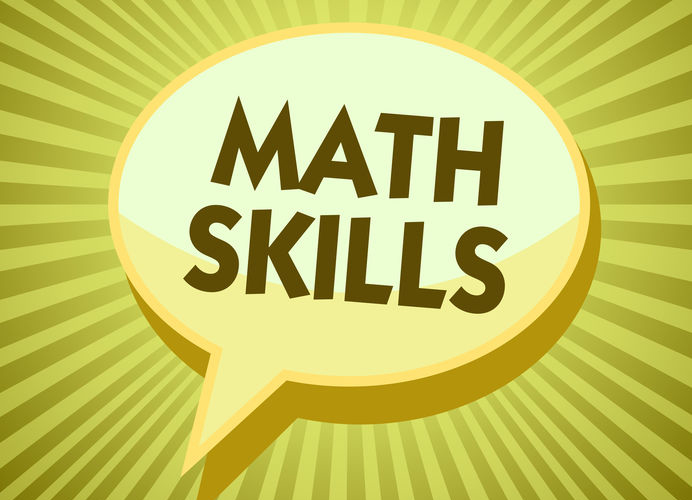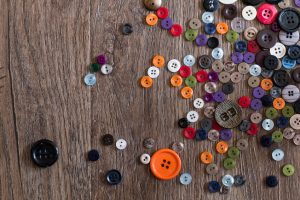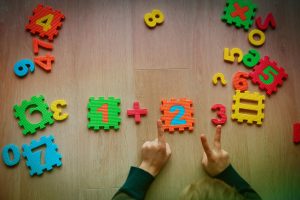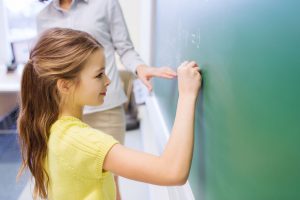How to teach kindergarten math skills – 5 Ways to Get Started

Teaching foundational math skills to kindergartners is essential to fostering young minds that can make sense of the world around you. Knowing just how critical these foundational skills are can be a daunting task for any teacher. However, there are countless strategies and methods to nurturing counting, adding and subtracting skills to sort through. Molding minds should be fun and rooted in enjoyable activities, so we’ve picked out five of our favorite ways to hook your kindergartners on math.
Play Games
The more interactive games you have at the ready, the more engaged your kindergartners will be when it comes to practicing their foundational math skills. For example, if you are practicing adding numbers within 10 you could have students pick two UNO cards and stack blocks of each number. Count how many blocks total and compare towers to learn greater than or less than.
If you have 10 empty toilet paper rolls and a tennis ball, you can play subtraction bowling. It won’t be long until all your kiddos are bragging that they know 10-10=0! These games can help your room be inclusive for all students, teach life skills like taking turns and being a good sport, and instill those essential foundational math skills.
The possibilities are endless when it comes to finding games. You can invent them yourself, check out our games on Math Discovery or scan through Pinterest. Games are the perfect marriage between having fun and developing new and important skills.
Read Books
There are so many classic books that are a rite of passage for emerging young mathematicians. Do you remember “Chicka Chicka 1,2,3” by Dan P. Lyons or “Inch by Inch” by Leo Lionni? These books stand the test of time and can lead to fun and engaging lessons. The more illustrated math books you introduce to your classroom the more likely a student will feel a connection with that book. When kindergartners feel a connection to books they are more likely to want to have that book at home. If parents or guardians are reading that book with the child at home then the likelihood of retention and success will skyrocket!
No matter what foundational skill you are teaching, from shapes to sorting, you should be able to find an illustrated book that fits that niche. You can usually find great lessons that will supplement popular illustrated books on Pinterest and websites like Math Discovery or Teachers Pay Teachers.
Play with Manipulatives and Toys
Similar to playing games, the more tactile toys or manipulatives you can use in the classroom the more likely you will have students engaged and stimulated. Colored math cubes are a classic manipulative that can help students with counting, adding, subtracting, and comparing. Wooden magnet numbers or touch math numbers/cards are also great for honing these skills. When it comes to shapes, tangrams are tried and true throughout generations as well. Additionally, new toys and manipulatives continue to emerge and provide engaging ways to promote learning. There are electronic dice, light up sorting cubes and many more products that could delight your classroom.
Practice with Fun Worksheets
Worksheets stand the test of time when it comes to developing all math skills. Extended practice of skills over time and given different scenarios is an excellent way to improve retention and prove growth. Additionally, worksheets are a great way to help students hone their time management skills and increase their ability to efficiently solve problems.
The key is to moderate your use of worksheets and workbooks and tie them into fun and engaging lessons. Worksheets that involve solving riddles and coloring pictures as an outcome of math skills add to engagement and helps keep students building towards something tangible. Please take a few minutes to review Math Discovery’s Free Kindergarten Math Worksheets!
Real-World Practice
Finally, there is no better practice than putting your new math skills into real-world situations. Cooking and eating are two life skills that partner very easily with foundational math skills. You can use packages of fruit snacks to practice counting and then subtracting. For example, you count the fruit snacks in your packet and eat a specific number of those snacks at a time. Next thing you know, you’ve practiced your subtraction skills and kids have a delicious snack in their tummy!
Additionally, using cups (whole numbers are best) to do simple recipes for cookies or other goodies is a great way to keep kids engaged and invested in the procedure from start to delicious finish!
Remember to always have fun and try as many strategies as possible. The more activities and ideas you have in your toolbox, the more you’ll witness incredible growth from your young mathematicians.
Here are a few other resources on the web you might find helpful!
6 Tips To Teach Kindergarten Math Without Curriculum: https://ihomeschoolnetwork.com/kindergarten-math/
17 Kindergarten Math Games That Make Numbers Fun from Day One: https://www.weareteachers.com/kindergarten-math-games/
https://www.k5learning.com/blog/why-math-worksheets-play-essential-part-learning-math



